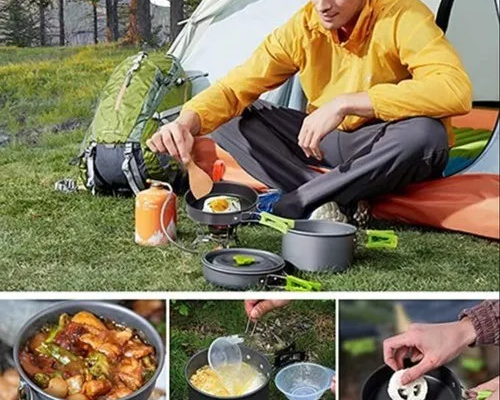Whether you’re planning a short weekend break, an extended camping trip, or an epic road journey across Australia, having the right equipment is essential for improving your outdoor cooking experience. It may be easy to pack your entire kitchen, but you must be careful about what you bring on the trip due to weight and space limitations. This is where having the right best camping products and equipment for outdoor cooking is essential. Proper cookware can help you prepare meals more easily and enjoyably while saving weight and space. In this guide, we’ll discuss some considerations for choosing the best camping cookware and offer advice on what to consider when selecting the appropriate equipment for your upcoming camping trip.
Cookset or Separate Parts: Which is Best?
You can purchase separate pieces of cookware or an entire cookset.
Cookset: These are sets of lids, pots, and pans for placing together. Certain cooksets include extras like glasses, mugs, or plates that fit within the pots.
Separate Parts: They allow you to create your set exactly how you want it. This method may not be the best if you want to decrease your weight for trekking. However, it’s an excellent way to add diversity to your cookware inventory.
Choices of Cookware Materials
The following is a list of some necessary choices for cookware materials:
Aluminum
Pros: It is lightweight, inexpensive, and an excellent heat conductor. Furthermore, it is ideal for cooking dishes without burning.
Cons: It degrades slowly when exposed to foods with acidity. It also causes dents and scrapes readily.
Stainless Steel
Pros: It is stronger and more scratch-resistant than aluminium.
Cons: It is heavier than aluminium and does not conduct heat uniformly (which might result in scorched food).
Hard-Anodised Aluminum
Pros: This oxidised substance is scratch- and abrasion-resistant and long-lasting.
Cons: None.
Titanium
Pros: It is popular as a super lightweight material for cookware. Also, it is the lightest option without compromised strength. Moreover, it is highly corrosion-resistant, rapidly heated, and efficient even at low temperatures.
Cons: It costs more than other materials and conducts heat less evenly than stainless steel. Be careful not to overheat it.
Cast Iron
Pros: It’s durable and perfect for frying or baking.
Cons: It is not ideal for backpacking and is somewhat heavy compared to other choices. It needs to be adequately cared for.
Nonstick Coatings
Pros: It simplifies cleanup.
Cons: Most can be scratched by metal utensils, and it is not as durable as ordinary metal surfaces.
Plastic
Pros: It is inexpensive, lightweight, and non-abrasive. It is also ideal for airtight food containers and utensils.
Cons: It is not as strong or resistant to heat compared to metal. Certain plastics can absorb and hold onto food smells and odours.
Additional Cookware Factors
Pot Size: The largest pot in your cook set should carry around 1 pint for each hiker or camper in your group.
Number of Pots: The number of campers in your group and the cooking you plan to conduct will decide this. One pot is sufficient if you intend to prepare to dehydrate. Larger gatherings and more complex dishes require more pots and pans. More complex dishes.
Pot Lifters or Grippers: Determine that you have a safe method for recovering your pots and pans. Most cook sets come with one gripper for each pot. Just make sure you bring it with you.
Lids: Lids save cooking time, save fuel, and decrease debris. Some cooksets include a cover for each pot, while others have a single lid that fits various pot sizes. Others can even function as fry pans. Specific lids can also function as plates, reducing your load.
Extras: Some cooksets include dishes, towels, cups, and cutlery. If you’re starting from the beginning, this can be useful; otherwise, it may not be necessary.
Safety Concerns of Cookware
Aluminium: Is using aluminium cookware unhealthy? According to reports from the Food and Drug Administration, the National Institutes of Health, and the London-based Alzheimer’s Society, no dangers are linked to using aluminium pots, pans, or skillets.
Nonstick Coatings: Cookware coated with food-grade fluoropolymer PTFE may release harmful fumes if overheated. These vapours have been known to kill pet birds and to give humans flu-like symptoms when inhaled. When cooking with nonstick cookware, use caution (don’t use it when grilling food) or consider using uncoated choices.
BPA: Older cookware may be harmed by an artificial substance known as bisphenol A (BPA). Every piece of cookware that REI sells is BPA-free when food or liquid comes into contact with it.
Conclusion
Portable camping cookware is essential for a successful outdoor adventure. Considering all the information in this guide, you can confidently choose a non stick cookware set suitable for your needs, whether you’re a novice or a seasoned camper. Don’t forget to purchase a lid to keep unwanted “visitors” away from your food and improve your outdoor dining experience.
